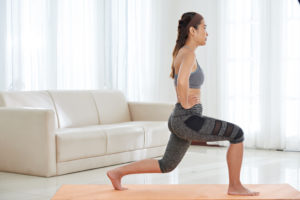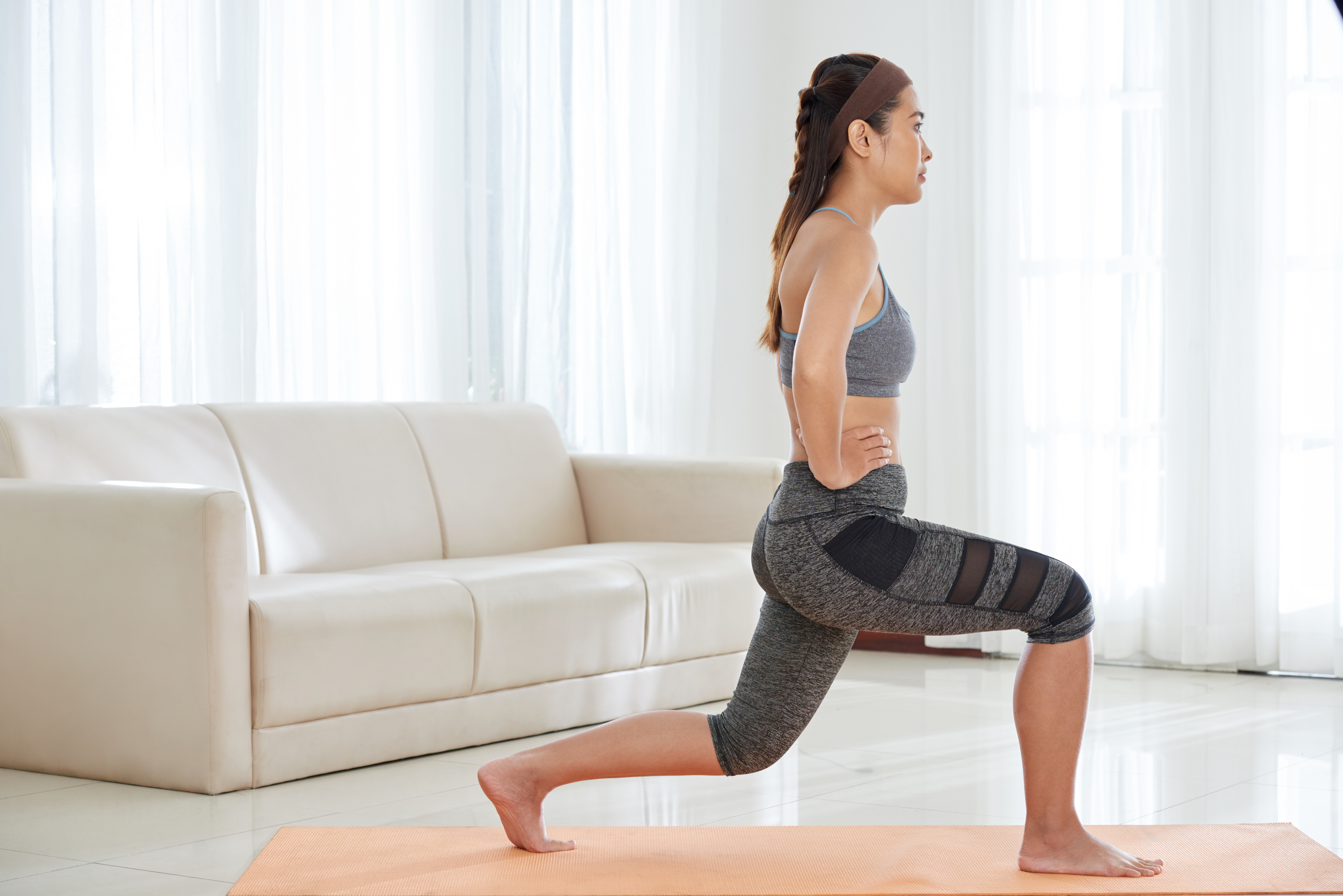
You need lunges in your lower body routine! They’re a basic exercise that works the muscles in the front and the back of the thighs as well as the glutes. They also offer a balance challenge to help you improve your proprioceptive skills. You can choose from a variety of lunge variations that are more difficult than a standard lunge. Here’s a simple lunge progression from easiest to hardest to help you get started with this lower body exercise.
Pulsing Lunge
The easiest way to get acquainted with lunges is to do a pulsing lunge. This movement targets primarily the quads but also works the hamstrings, glutes, and calves to a lesser degree. It’s a good introduction to the exercise because it will teach you the appropriate movement patterns you need to progress into more advanced lunges. Here’s how to do one:
•Step one foot forward and descend into a standard lunge with your legs at a 90-degree angle.
•Keep your weight on your front heel as you pulse up and down.
•Do ten pulses and switch legs.
Backward Lunge
Why begin with a backward lunge? It might sound a bit “backward,” but there are reasons. The backward lunge is a safer movement if you have knee pain Lunging backward places less stress on the knees since the momentum is shifted back rather than forward. Yet, it still strengthens the muscles in your lower body, including the quads, hamstrings, and glutes. Plus, you’re generating the power to lunge from the leg that stays on the ground. This makes backward lunges easier to perform, as you’re in a more stable position. So, start with backward lunges before tackling a forward one.
Here how to do one:
•Stand upright with your hands on your hips and spine neutral.
•Step your right foot back behind you as you descend into a lunge. Your right knee should almost touch the floor at the bottom of the lunge.
•Use your right foot to push yourself back to the starting position.
•Repeat the same sequence stepping your left foot back.
•Keep alternating legs.
Forward Lunge
After you’re comfortable with pulsing and backward lunges, get ready to try a full, forward lunge. As mentioned, it’s more of a balance challenge as your body is less stable when you step forward than when you step back. It’s also harder on the knees as it increases the compressive forces on the knee joint. You can lower the risk of knee injury by not letting your knees go over your toes. On the plus side, the added instability means your core muscles get more of a workout. Nothing wrong with a little extra core work!
Here’s how to do one:
•Stand upright with your hands on your hips and your spine neutral.
•Step your right foot forward as you lower your body into a lunge position. Lower your body to the point that your left knee almost touches the floor.
•Use your right foot to push your body back to the starting position.
•Repeat the sequence by stepping your left leg forward as you lower your body into a lunge position.
•Use your left foot to push your body back up to the starting position.
•Keep alternating legs.
Lateral Lunge
Once you’ve mastered the forward and backward lunge, tackle a lateral lunge. Lunging laterally offers benefits you won’t get from forward and backward lunges. This move works your inner thighs more, a muscle group that often gets neglected. Here’s how to do one:
•Stand facing front with your feet wider than shoulder-width apart.
•Shift your body weight to the right leg as you lower your body as far as you can to the right side. Your left leg should remain straight.
•Use your left foot to push your body back to the starting position.
•Now, shift your body weight to the left leg as you lower your body to the left. Keep your right leg straight.
•Use your right foot to push your body back to the starting point.
•Alternate back and forth.
Forward to Backward Lunge
This is a more advanced variation that’s more dynamic and requires greater agility and coordination. Don’t try it until you’ve mastered the forward and backward lunge. Here’s how to do it:
•Stand upright with arms by your side and spine neutral.
•Step your right foot forward and do a full, forward lunge.
•Push off your right foot and immediately bring your right leg back behind you as you do a backward lunge.
•Return to the starting position and switch legs.
•Continue to alternate legs as you complete a forward and backward lunge on each side.
More Advanced Lunges
These aren’t the only lunge variations you can do. For example, you can create an added balance challenge by placing your foot on an unstable surface, like a BOSU ball, when you do forward lunges. The foot that moves forward lands on the rounded portion of the ball. You can also make the move more dynamic by doing walking lunges where you step forward with your right leg and descend into a lunge. Then use your right foot to keep you stable as you bring your left leg forward into a lunge on the opposite side. Keep switching back and forth as you move across the floor. But, master the basics first!
Tips for Safer, More Effective Lunges
Always begin a lunge workout with a dynamic warm-up. Good exercises for getting lunge-ready include leg swings, butt kicks, and high knees. Since the emphasis is on the lower body, you want the muscles you’re working to be warm and ready to work. If you have knee problems, stick mainly to backward lunges as they place the least compressive forces on the knees. If you do forward lunges, decrease the depth to which you descend. In other words, don’t go all the way down.
Conclusion
Lunges are an ideal exercise for the quads and they also target the hamstrings and glutes. Start with the basic moves, and prioritize backward lunges over forward ones if you have a history of knee pain. They can also help improve your balance.
